| |

Sitting overlooking the ocean on the edge of the island, while listening to reggae music, writing our journals, and watching the sun set, is a great way to end a terrific day. Today we had a fun time visiting with students at Saramen Chuuk Academy, where we got answers to your questions, and some questions for you to answer. We also learned about early Micronesian history. We're really excited to share all of our adventures with you.
We met with over 100 students today who answered many of your questions. But before we get to that, I want to ask for your help again. We need you to respond to the questions that Chuukese students asked about Americans. I've included a bunch of these later in this entry. To go directly to the questions, click here.
You're not off the hook yet! I have one more request. Can you help think of questions to ask the family we will have dinner with later during this trip? Keep in mind that I don't think that the older members of the family speak English, and their high school age children may have to translate.
Saramen Chuuk Academy
(Click on any photo to enlarge it.)
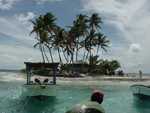 After morning wreck diving, Tom and I had lunch on a tiny island with just one house and a few palm trees. It was something really special.
After morning wreck diving, Tom and I had lunch on a tiny island with just one house and a few palm trees. It was something really special.
In the afternoon we visited Saramen Chuuk Academy, a private, Catholic High School with 250 students. The students all come from Chuuk State. While most students live on the main island of Weno, many come to school each day by boat. Can you imagine your school bus being a motorboat?
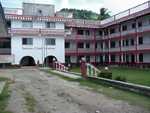 When we arrived at the school, we were given a tour of the grounds. I thought it was strange that the hallway is outdoors, but then again, even in winter it is always warm here. While touring, I was struck by how bare the classrooms were compared to those in the U.S. There was nothing on the walls, and nothing in the rooms except for students sitting quietly at tiny desks.
When we arrived at the school, we were given a tour of the grounds. I thought it was strange that the hallway is outdoors, but then again, even in winter it is always warm here. While touring, I was struck by how bare the classrooms were compared to those in the U.S. There was nothing on the walls, and nothing in the rooms except for students sitting quietly at tiny desks.
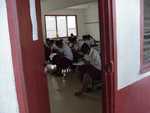 In fact, the science lab had nothing in it at all -- no lab equipment, not even desks! We learned that the students use it for drama club meetings.
In fact, the science lab had nothing in it at all -- no lab equipment, not even desks! We learned that the students use it for drama club meetings.
By American standards, the library looked especially empty, just three or four large shelves of books and some dictionaries. The librarian was very excited when she saw our gift to the school - a new World Atlas. I told the librarian that we had asked you all for ideas, and one suggestion had been to bring the school a new atlas. (Great thinking, everyone!)
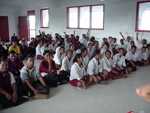 After our tour, we entered a large room filled with every junior and senior in the school --about 110 students. The students were sitting quietly on the floor, not quite sure of what they should expect from us. Actually, I'm not sure what I expected, but I certainly didn't expect over 100 faces staring at me! All the students were dressed in uniforms of white shirts and red skirts or pants.
After our tour, we entered a large room filled with every junior and senior in the school --about 110 students. The students were sitting quietly on the floor, not quite sure of what they should expect from us. Actually, I'm not sure what I expected, but I certainly didn't expect over 100 faces staring at me! All the students were dressed in uniforms of white shirts and red skirts or pants.
We explained what we were doing and why we came to visit their school: to help American students learn more about Micronesian culture and teens. Then we asked them many of your questions. Here are some of the questions, along with the answers we received. When speaking with these students, I noticed how very respectful they were. It seems that they really appreciate the opportunity to get a good education, and don't take it for granted.
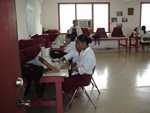 We asked the students, "Do you have a television?" All of them said yes. "Do you have a computer?" About half have one at home and most of those have Internet access. "Do you like pizza?" All said yes. "Do you have your own car?" About half of the students do.
We asked the students, "Do you have a television?" All of them said yes. "Do you have a computer?" About half have one at home and most of those have Internet access. "Do you like pizza?" All said yes. "Do you have your own car?" About half of the students do.
Next we asked them about their typical day in school. They said they study all sorts of subjects, some the same as in the U.S., some different. They study English, math, religion (remember, it is a Catholic school), history, science, chemistry, Japanese (language), business, and computers. One student said school is fun or boring, depending on the day, her mood, and the teachers.
One class, unlike any common course in the U.S., is called "Traditions." Traditions class aims to help today's students remember their past and their history. In this class, students don't use notebooks. Instead they get to work learning about their country's oral history, traditional rituals, ceremonies, dances, songs, and how to prepare food the way it was prepared a long time ago. For example, students learn to cook crab soup made with coconut milk and how to pound breadfruit in the traditional way. Before I started on this trip, I researched Micronesian history a little. Click here to read what I learned.
We also asked students what they do for fun during their free time. They really liked answering this question! Many of the teens like to go on campouts with their friends to the small islands where no one lives (like the one we ate lunch on). They go by boat and bring overnight gear and food for a picnic.
All the teens like to cruise around by car with their friends -- sound familiar? They like to visit friends and just hang out. Going to reggae music concerts is also a favorite activity. Many of the students like to spear fish, a type of fishing where you catch fish with what is a sharp, multi-pronged stick.
One of you wanted us to ask students about how they celebrate Christmas. This question led to a lively discussion about celebrating holidays of all sorts. The school is having a big haunted house and Halloween party this weekend. Then they are off school for All Saints Day the following Monday. Everyone trick-or-treats, even the older kids and teens. Christmas celebrations vary. Some students described a long celebration that runs right into the new year. In fact, it sounds like the whole island celebrates New Year's with a 48-hour long party! Similar to Halloween, people go around knocking on each other's doors to visit and party.
Family gatherings and gift-giving make up an important part of Christmas here. One student said that people don't shop months in advance but instead get gifts at the last minute. I'm not sure whether that is just her own habit or the way everyone does it! Christmas day itself is reserved for religious ceremonies.
Questions for You
Finally, we asked the Saramen students what they wanted to know about you. I will take your answers and email them to the students. Here are the questions. Remember, many of the questions are based on what the students see about American school life from the movies or TV.
What time do you get out of school?
Do older students treat freshmen in high school poorly?
Do you have "tough guys" in your school?
How is your school similar or different from the ways high schools are portrayed in the movies?
Have you ever tasted fresh coconut?
Are there "gangsters" in your school or neighborhood?
How do you dance?
What do you do on the weekends?
Do you have a Traditions class like we do here?
What is your culture like, and what are your traditions (how do you celebrate holidays and which holidays)?
Would you like to be email pen pals with a student from Saramen Chuuk Academy?
At the end of our visit, the students sang us their school song. We captured some of it on
video to share with you.
Early Micronesia History
Learning about the Saramen Chuuk Academy Traditions class made me glad I had read up on Micronesian history before coming. When I travel, I like to learn about a country's history because knowing the history helps me put what I see into perspective.
As the story goes, the first settlers to Micronesia came by canoe from the Philippines and Indonesia between 4000 and 2000 B.C. Much later, voyagers from Melanesia worked their way across the islands.
Having one of the greatest sea-traveling cultures in the world, Micronesians sailed between the islands in huge canoes. They guided themselves by the stars, sun, wind, and birds. These early Micronesian sailors were so skilled that they could even read wave and wind patterns to help them locate and avoid hard-to-see low-lying atolls.
Early Micronesians probably lived on the fish they caught, as well as by gathering and farming. Though they had no metals, they worked expertly in stone and left behind many impressive carvings. Sadly, the rich Micronesian oral history did not survive as well as the carvings. The oral history has been largely lost.
Thousands of years passed, and the Micronesians carried on, minding their own business and developing their own unique cultures, languages, and traditions. What changed, you may ask? (I sure did).
The answers are found in Europe. In the 16th century during the height of the spice trade, Portugal denied Spain access to an important trading route. Unwilling to give up the profitable spice trade, Spain assigned Ferdinand Magellan the task of finding a way to get east by going west. During their voyage in 1521, he and his men bumped into a group of Micronesians in a canoe near Guam. The meeting was not friendly. Islanders stole Magellan's skiff and Magellan and his crew responded by burning 50 houses and boats and killing seven men in the process of recovering it.
For a long time afterward, not many people visited Micronesia because the islands did not fall in the path of popular trade routes. However, in 1565, a Spanish ship called the San Lucas veered from its familiar route and became the first European vessel to visit Chuuk Lagoon.
Toward the middle of the 17th century, Spain became increasingly interested in the Marianas, a chain of islands in Micronesia. Spain sent people to the Marianas to start a Spanish colony. These colonists forced Spanish culture, language, and religion on the islanders, a process that would later become a trend on other Micronesian islands.
British whalers started arriving in the area in the early 1800s. Americans followed not long after, during the whaling boom in the 1840s. Whalers and traders used the islands as stopover places to replenish food and water. They often mistreated the Micronesians and worse, introduced diseases such as smallpox, measles, and influenza to the islands. With no natural defenses again these diseases, many Micronesians died.
In 1870, the U.S. sent missionaries to eastern Micronesia. As in the Marianas, these missionaries imposed Western clothing, laws, religion, and language on the islanders. These missionaries were the first people to translate and write down Micronesian languages. As these missionaries worked their way west from the Marshall Islands, Catholic missionaries worked their way east from the Marianas. They met around the central Caroline Islands. That is why today the FSM is almost equally divided between Catholics and Protestants.
In 1885, the Micronesian islands came to the attention of the Pope. The Spanish and the Germans were fighting over who had the right to claim the lands. The Pope ruled that Spain owned the land and had administrative rights, but that Germany could establish industries there.
Spain ceded more rights to Micronesia after the Spanish-American War. Because Spain lost the war, they had to turn over some Micronesian possessions to the U.S. By 1899, Spain sold its remaining territories to Germany.
The Germans hoped to milk Micronesia for its copra (coconut) resources. They set up factories, mines, and plantations, requiring islanders to work against their will. German occupation didn't last long. When the World War I broke out in 1914, the Germans cut their losses and abandoned the islands.
After the Germans left, the Japanese (who had been trading in the region for years) took control of the Micronesian islands. Japanese colonization lasted roughly 30 years. In 1920, the League of Nations granted the Japanese formal control over the islands.
Under Japanese rule, the Micronesian islands reached their height of agricultural and economic productivity. Japan installed a badly needed infrastructure of roads, hospitals, and water systems. Eventually, the number of Japanese in the islands outnumbered the number of Micronesians, and the islands' social infrastructure became geared to Japanese needs. Micronesians became second-class citizens.
While building the badly needed infrastructure, the Japanese also built traditional Japanese structures, like Buddhist temples and public baths. These served as physical reminders that the "tiny islands" were being shaped into "tiny Tokyos." And, in retrospect, some Japanese preparations, such as airfields, seaplane ramps, and other fortifications (which violated the League of Nations mandate) became protection for "big Tokyo" during the years of WWII.
You'll hear more about Micronesia's involvement in WWII in future journal entries. Keep your eyes peeled for it because it is fascinating, and you won't want to miss it.
We'll talk to you tomorrow!
Karen
|


